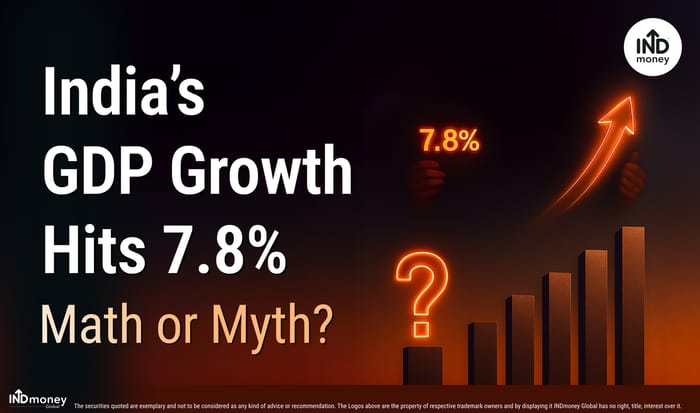
- Nominal vs Real GDP: The Two Stories
- What is the GDP Deflator?
- Why Does the GDP Deflator Matter So Much?
- Is a 1% Deflator Justified?
- So, Is India Really Growing at 7.8%?
- Why Does This Matters?
India’s economy just posted a headline-grabbing 7.8% real GDP growth in Q1 FY26, instantly making it the fastest-growing major economy in the world. On paper, that sounds like a dream run; a signal of booming demand, strong businesses, and unstoppable momentum. But dig beneath the surface, and the picture looks more complicated. Is this rapid growth a genuine surge in activity, or does it owe more to the way the numbers were calculated?
Let’s break it down.
Nominal vs Real GDP: The Two Stories
Think of GDP in two ways:
- Nominal GDP: Growth including inflation (how much money value of the economy expanded).
- Real GDP: Growth after stripping out inflation (how much actual production of goods and services grew).
Here’s how the numbers looked:
| Quarter | Real GDP Growth | Nominal GDP Growth |
| Q1 FY25 | 6.5% | 10.8% |
| Q1 FY26 | 7.8% | 8.8% |
Source: MoSPI
At first glance, real GDP growth jumped from 6.5% to 7.8%, while nominal growth slowed from 10.8% to 8.8%. Normally, real growth should move in the same broad direction as nominal growth, but here the opposite happened.
The reason lies in something called the GDP deflator.
What is the GDP Deflator?
The deflator measures the impact of price changes on GDP. In simple terms, it tells us how much of GDP growth came from higher prices versus more goods and services produced.
Think of it like a train journey:
- Nominal GDP is the ticket fare you paid.
- Along the way, chai and samosa prices may go up. That’s inflation.
- The GDP deflator adjusts for that inflation.
- The final real GDP shows the actual cost of the journey without price hikes.
In Q1 FY26, the deflator used was just about 1%, one of the lowest in recent years. That’s what pushed the real GDP growth number higher.
Why Does the GDP Deflator Matter So Much?
Here’s an example. Suppose you spent ₹1,000 last year and ₹1,200 this year. If all of the extra ₹200 was due to higher prices, your real consumption didn’t really grow. The deflator is what separates higher prices from actual volume growth.
The formula is straightforward:

Plugging in the numbers:
- With 8.8% nominal growth and a 1% deflator, real GDP looks like ~7.8%.
- But if the deflator were 2%, real GDP would come down to 6.7%.
That’s a big difference.
Is a 1% Deflator Justified?
Here’s where things get tricky. India’s deflator is based on 60% wholesale price index (WPI) and 40% consumer price index (CPI). This year, WPI hovered near zero while CPI averaged around 2.7%. Combined, the blended deflator was roughly 1%.
But there’s a catch:
- WPI ignores services entirely.
- Services make up nearly two-thirds of India’s economy.
- Using WPI so heavily can understate inflation pressures, especially when service prices (education, healthcare, travel, rent) are rising faster than wholesale goods prices.
So, while the official formula produced a 1% deflator, many economists argue that a more realistic number is closer to 2%.
So, Is India Really Growing at 7.8%?
The answer depends on which deflator you believe.
- Official reading: 7.8% growth, fastest among large economies.
- Adjusted with 2% deflator: closer to 6.7%, still strong but not as dazzling.
Either way, India’s economy is performing better than most global peers. But the gap between perception and reality highlights how much GDP numbers depend on methodology.
Why Does This Matters?
For investors, the distinction is critical. A higher real GDP growth rate can drive optimism in equity markets, suggesting stronger demand and earnings potential. But if the number is inflated by statistical quirks, it could paint an overly rosy picture.
For policymakers, underestimating inflation through a low deflator can create the illusion of higher growth, potentially leading to looser policy decisions than warranted.
India’s 7.8% growth figure isn’t entirely a myth, but it isn’t the whole truth either. The strong headline number has been boosted by an unusually low deflator. Adjust for a more realistic inflation measure, and growth looks closer to 6.7%, still healthy, but not quite the breakout that headlines suggest.
As always, the real story lies not just in the numbers but in how we interpret them.
Disclaimer:
The content is meant for education and general information purposes only. Investments in the securities market are subject to market risks, read all the related documents carefully before investing. Past performance is not indicative of future returns. The securities quoted are exemplary and are not a recommendation. This in no way is to be construed as financial advice or a recommendation to invest in any specific stock or financial instrument.The figures mentioned in this article are indicative and for general informational purposes only. Readers are encouraged to verify the exact numbers and financial data from official sources such as company filings, earnings reports, and financial news platforms. The Company strongly encourages its users/viewers to conduct their own research, and consult with a registered financial advisor before making any investment decisions. All disputes in relation to the content would not have access to an exchange investor redressal forum or arbitration mechanism. Registered office address: Office No. 507, 5th Floor, Pragya II, Block 15-C1, Zone-1, Road No. 11, Processing Area, GIFT SEZ, GIFT City, Gandhinagar – 382355. IFSCA Broker-Dealer Registration No. IFSC/BD/2023-24/0016, IFSCA DP Reg No: IFSC/DP/2023-24/010